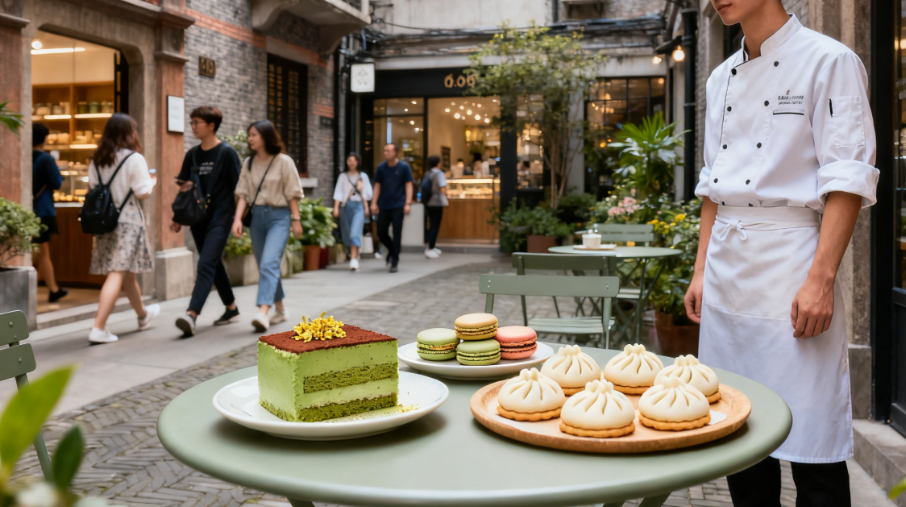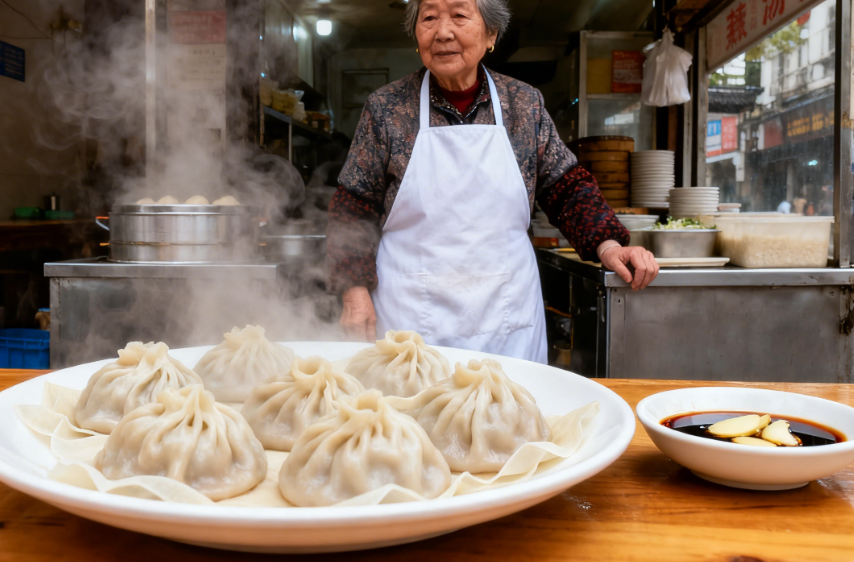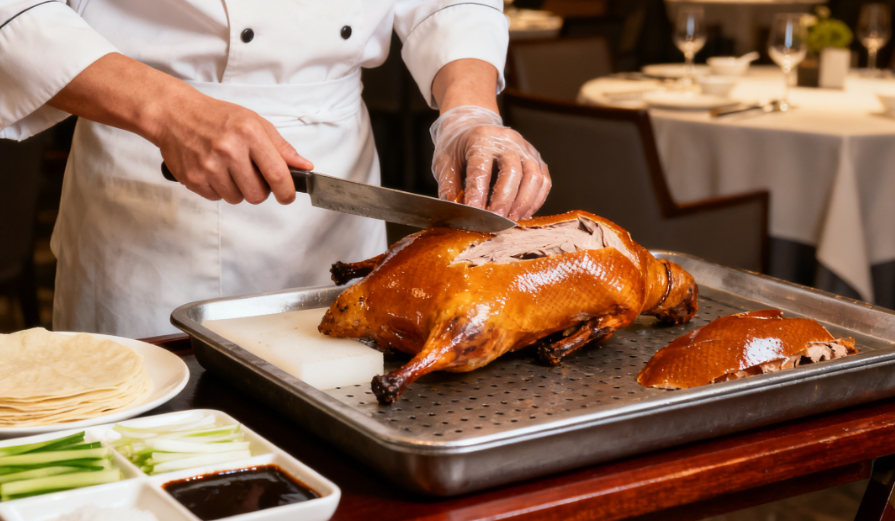
Bite into Shanghai: My Culinary Journey Through Street Stalls and Fine Dining
For me, Shanghai’s food is more than sustenance—it’s a window into the city’s soul. From Mrs. Li teaching me to eat xiaolongbao at her Huanghe Road stall to an 80-year-old grandmother making tangyuan in Qibao Old Street, every meal came with stories and warmth. This piece shares my journey through the city’s culinary layers: the casual joy of Wujiang Road’s street food, the nostalgia of benbang cuisine at 1862-founded Lao Zheng Xing, and the excitement of fusion dishes at Warehouse No. 3. It’s a love letter to Shanghai, written in flavors.
My love affair with Shanghai’s food began on a crisp autumn morning in Yu Garden, when I bit into a steaming xiaolongbao (steamed soup dumpling) and felt its savory broth burst on my tongue. That single bite—tender wrapper, juicy pork, and a hint of ginger—captured everything I’d heard about Shanghai’s cuisine: delicate yet flavorful, traditional yet adaptable. Over three trips spanning five years, I’ve eaten my way from street stalls to Michelin-starred restaurants, from dawn breakfasts to midnight snacks. What makes Shanghai’s food scene unique is its duality: it honors centuries-old recipes while embracing bold innovations, blending local “benbang” (native) flavors with influences from across China and the world. This is my story of exploring Shanghai through its food—a journey that taught me more about the city than any guidebook ever could.
Street Food: The Soul of Shanghai’s Daily Life
To understand Shanghai’s food, you must start with its street stalls. These humble setups, often run by families for generations, serve the dishes that locals eat daily, and they’re where I’ve had some of my most memorable meals. My first stop on any trip is always a xiaolongbao stall—preferably Jia Jia Tangbao on Huanghe Road, made famous by the TV series Blossoms Shanghai . Unlike the tourist-friendly versions at Yu Garden, Jia Jia’s dumplings have thinner wrappers and more concentrated broth. The owner, an elderly woman named Mrs. Li, taught me the proper way to eat them: “Bite a small hole, slurp the soup, then dip in rice vinegar with ginger.” I followed her advice, and that simple ritual turned a snack into an experience.
Another street food staple I can’t resist is shengjian mantou (pan-fried pork buns), especially from the 30-year-old stall on Nanjing Road . These golden buns have a crispy bottom that crunches when you bite into them, giving way to juicy pork filling infused with scallions. I’d often pair them with a cup of warm soy milk from a nearby cart, watching locals rush by with their morning snacks. For something sweeter, I seek out crab shell cakes (xie ke huang)—flaky pastries filled with either sweet red bean paste or savory sesame—from the stalls near Chenghuang Temple. They’re perfect for walking around Yu Garden, their buttery aroma mixing with the scent of osmanthus tea from nearby teahouses.
No street food tour is complete without a visit to Wujiang Road, a narrow lane that’s been a favorite among local foodies for decades . Here, I’ve tried everything from stinky tofu (crispy on the outside, tender inside, served with spicy sauce) to youdoufu chuan (fried tofu skewers in savory broth). My go-to spot is a tiny stand run by a couple who serve shengjian hun tun (pan-fried wontons) with a side of spicy pickled vegetables. The husband fries the wontons until they’re golden, while his wife chats with regulars in rapid Shanghainese. Even though I don’t speak the language, her warm smile and the smell of frying garlic made me feel welcome.

Benbang Cuisine: Shanghai’s Timeless Classics
While street food is casual, Shanghai’s benbang cuisine is where the city’s culinary heritage shines. Benbang dishes are known for their “nong you chi jiang”—rich oil and red sauce—and a perfect balance of salty and sweet . I first tried authentic benbang food at Lao Zheng Xing, a historic restaurant founded in 1862 that’s kept its traditional recipes alive. The moment I walked in, I was greeted by the aroma of braised meat and soy sauce, and the walls lined with black-and-white photos of old Shanghai added to the nostalgia.
My favorite benbang dish is xiang you shan hu (braised eel with fragrant oil), a dish that requires precise heat control to keep the eel tender. The eel is cut into sections, fried briefly, then braised in a sauce of soy sauce, sugar, and rice wine until the sauce clings to every piece. Every bite is savory with a hint of sweetness, and the eel melts in your mouth. I also fell in love with zao ji (drunken chicken), where chicken is marinated in rice wine and fragrant(zao) sauce—a specialty that’s light yet full of flavor . The waiter explained that the zao sauce is made from fermented rice and aged rice wine, a recipe passed down for generations.
Another benbang classic not to miss is cao san si (shredded three delicacies), a dish that showcases Shanghai’s knife skills. Chef’s shred ham, chicken breast, and pork into thin strands, then braise them in a clear broth until tender. It’s a simple dish, but the texture and subtle flavor make it unforgettable. For dessert, I always order jiu niang yuan zi (glutinous rice balls in rice wine soup)—soft rice balls filled with red bean paste, floating in a sweet, slightly alcoholic broth . It’s the perfect way to end a rich benbang meal, and the warmth of the soup is comforting on cool evenings.
Creative Fusion: Where Tradition Meets Innovation
Shanghai’s food scene isn’t just about preserving the past—it’s also about reimagining it. On my last trip, I visited 3号仓库·创意中国菜 (Warehouse No. 3), a creative restaurant in Sichuan North Road that blends benbang flavors with international techniques . The space itself was a surprise: 1680 square meters of futuristic design with mirror walls, metal installations, and a rooftop terrace with views of Lujiazui’s skyline. But the real star was the food.
The signature dish was huo yan lei pai (flaming ribs), a theatrical masterpiece. The ribs are wrapped in rice paper, and when the waiter opens the “magic book” serving dish, he lights the rice paper on fire. As the flames die down, the rice paper’s sweetness infuses the ribs, and the dish is served with crispy tea leaves to cut through the richness. It was unlike any benbang dish I’d tried—bold, creative, yet still rooted in Shanghai’s love for balanced flavors. I also tried their “roast duck three ways”: first, duck with foie gras and caviar; second, duck wrapped in spring roll skin and fried; third, crispy duck bones with salt and pepper . Each bite was a new adventure, and it showed how Shanghai’s chefs are pushing boundaries while respecting tradition.
Fusion in Shanghai isn’t just about high-end restaurants—it’s also in neighborhood spots. I visited a small café in Tianzifang that served “Shanghai-style afternoon tea”: green tea tiramisu, osmanthus macarons, and xiaolongbao-shaped cookies. The owner, a young chef who studied in Paris, told me she wanted to “make Shanghai’s flavors accessible to everyone.” I sat in the café’s courtyard, sipping osmanthus tea and eating her creations, watching tourists and locals walk by. It was a perfect example of Shanghai’s culinary identity: proud of its roots but open to new ideas.

Food Streets and Markets: Where to Eat Like a Local
If you want to dive deep into Shanghai’s food culture, head to its iconic food streets and markets. One of my favorites is Yunnan South Road, a historic street lined with century-old restaurants . Here, I ate xian de lai’s pai gu nian gao (fried pork ribs with rice cakes), a dish where crispy ribs are served with soft rice cakes in a sweet-savory sauce. The restaurant has been around since 1927, and the current owner is the third generation to run it. He told me that the sauce recipe hasn’t changed in nearly 100 years—“only the quality of the ingredients gets better.”
Qibao Old Street is another must-visit, especially if you want to combine food with scenery. This ancient water town has stalls selling everything from sweet lotus root to laoya fen (duck blood soup) . I tried the local specialty, qibao tangyuan (glutinous rice balls filled with sesame or peanut paste), at a stall run by an 80-year-old grandmother. She made the tangyuan by hand, rolling each one between her palms before dropping it into boiling water. The result was soft and fragrant, and she insisted I add a spoonful of osmanthus honey for extra flavor.
For a more modern experience, I recommend Xintiandi, where historic shikumen (stone-gate) houses have been converted into restaurants and cafes. Here, I ate at a restaurant that served “modern benbang” dishes, like black truffle xiaolongbao and crispy skin chicken with citrus sauce. While it’s more expensive than street stalls, the combination of historic setting and innovative food makes it worth it. After dinner, I wandered the streets with a stick of tanghulu (candied hawthorn berries)—a sweet, crispy snack that’s been popular in Shanghai for centuries .
Practical Tips for Eating in Shanghai
Based on my years of exploring Shanghai’s food scene, here are some tips to help you eat like a local:
Follow the crowds: The best street stalls always have long lines of locals. Don’t be afraid to wait—most lines move fast, and the food is worth it.
Learn basic phrases: Knowing “duo shao qian” (how much is it) and “bu yao la” (not spicy) will go a long way, especially at small stalls where English isn’t spoken.
Carry cash: Many street stalls only accept cash, so keep small bills handy. Larger restaurants accept Alipay and WeChat Pay, but having cash is safer.
Eat seasonally: Shanghai’s chefs prioritize fresh, seasonal ingredients. In spring, try荠菜 and bamboo shoots; in autumn, look for crab dishes (a local favorite).
Book ahead: Popular restaurants like Lao Zheng Xing and Warehouse No. 3 get busy, especially on weekends. Call or use a food app to reserve a table.
Final Thoughts
Shanghai’s food is more than just sustenance—it’s a reflection of the city’s soul. Every dish tells a story: the xiaolongbao from Jia Jia Tangbao speaks to generations of family tradition; the flaming ribs at Warehouse No. 3 show Shanghai’s willingness to innovate; the tangyuan from Qibao Old Street connects the city’s past to its present. What I love most is how accessible Shanghai’s food is—you can have a world-class meal for 50 yuan at a street stall or 500 yuan at a fine dining restaurant, and both will be equally memorable.
On my last night in Shanghai, I sat on the Bund, eating a shengjian mantou and watching the skyline light up. As I bit into the crispy bun, I thought about all the flavors I’d experienced—sweet, savory, spicy, delicate—and how they mirrored Shanghai itself: diverse, complex, and full of surprises. Whether you’re a food lover or just someone who wants to understand the city, Shanghai’s food will welcome you with open arms. All you have to do is take a bite.
Recommended

The Ultimate Guide to China's 30-Day Visa-Free Policy: Are You Eligible?
Great news for global travelers! As of November 20...

Beijing Travel Guide: Uncover the Heart of China’s Past and Present
As someone who has wandered Beijing’s hutongs, mar...

No Visa, No Cash, No Worries: The Ultimate Survival Guide to China in 2025
a local travel expert breaks down the revolutionar...

Best Places to Visit in China: My Journey Through History, Nature, and Modernity
Over the past five years, I’ve traveled to more th...

“Your Guide to Fast & Easy Payment for Chinese Consulate Services (2025)”
The document explains service fee standards for co...

China Travel Tips: My Love Letter to the Middle Kingdom After Dozens of Trips
After 20+ trips across China, I’m spilling all my ...

Step-by-Step Guide: How to Apply for Your China Visa in late 2025
Great news for travelers! As of September 30, 2025...

Beijing Transportation Guide: Navigate the Capital Like a Local
During my two years living and working in Beijing,...

My Journey Through Chinese Cuisine: A Symphony of Flavors
When I first set foot in China, I knew food would ...

Shanghai A Slow Journey Through Baoshan’s Golden Autumn: History, Nature, and Nostalgic Flavors
Seeking a break from the fast pace of city life, I...

Beijing Food Guide: A Culinary Journey Through History and Flavor
Having spent over a year living in Beijing, I’ve w...

Shanghai’s A Wellness Journey Through Minhang’s Rural Retreats: Health, Heritage, and Harvest
As someone who craves balance between city life an...